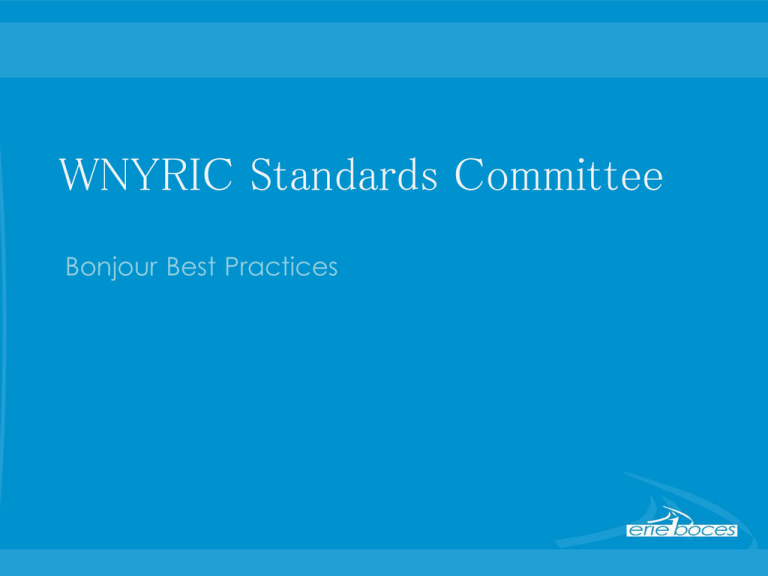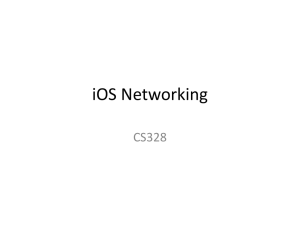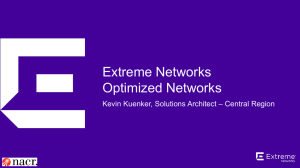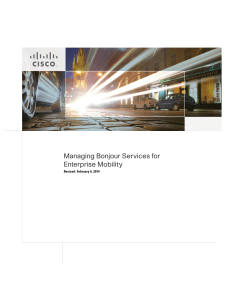Bonjour-Standards
advertisement

WNYRIC Standards Committee Bonjour Best Practices Bonjour • Bonjour, also known as zero-configuration networking, enables automatic discovery of computers, devices, and services on IP networks. Bonjour uses industry standard IP protocols to allow devices to automatically discover each other without the need to enter IP addresses or configure DNS servers. Specifically, Bonjour enables automatic IP address assignment without a DHCP server, name to address translation without a DNS server, and service discovery without a directory server. Bonjour is an open protocol which Apple has submitted to the IETF as part of the ongoing standards-creation process. – Bonjour lets you connect a printer to your network without the need to assign it a specific IP address or manually enter that address into each computer. With zero-configuration networking, nearby computers can discover its existence and automatically determine the printer’s IP address. And if that address is a dynamically assigned address that changes, they can automatically discover the new address in the future. Bonjour – mDNS Requests • In large network environments where there are many service requests from many users and applications, a flood of responses from multitudes of servicing devices will occur. • – “Server-free addressing, naming, and service discovery have the potential to create a significant amount of excess network traffic, but Bonjour takes a number of steps to reduce this traffic to a minimum. … Bonjour makes use of several mechanisms for reducing zero-configuration overhead, including caching, suppression of duplicate responses, exponential back-off, and service announcement” Even with this suppression, there is still a need for network design considerations to further reduce this traffic, lest it overwhelm the existing infrastructure. Bonjour – mDNS Requests • In a modern well-designed wired network, there should be ample capacity to handle a large-scale Bonjour deployment • There are concerns with the way multicasts and broadcasts are handled on a wireless network. – On a wireless network, every device will connect with a best bandwidth effort attachment, depending upon distance from the wireless access point (AP) and wireless frequency spectrum conditions such as interference. A device may quite possibly connect at the lowest allowed bandwidth setting of the overall wireless network. • The mDNS traffic will be generated at the rate of the lowest common bandwidth of connected devices. Bonjour - Availability • Another issue for network administrators to resolve is what services are available to which users on different subnets and providing an understandable device name. – This feature of the protocol creates a problem for a segmented network. • Therefore, without some form of intervention, users will not see services available on other subnets in a segmented network. Bonjour Gateways • A “Bonjour gateway” can be deployed on multiple subnets to listen to all the mDNS requests and responses. – Bonjour services can be accessed even when the Bonjour device is connected via an Ethernet cable on a network. The VLAN of wired Bonjour devices must be trunked to the [wireless] controller so that their advertisements can be seen and sent out to wireless clients • In general, the Bonjour gateway will build a table of devices, services, and IP addresses of the subnets it is connected. Bonjour Gateways • Cisco’s Bonjour gateway, also known more formally as Cisco Service Discovery Gateway, has been introduced in version 7.4 of its wireless controller. • Aruba Networks has introduced its Bonjour gateway in 2012. • Aerohive Networks support a Bonjour gateway, but they also make a free version available to overlay other vendor networks. – The free Bonjour Gateway supports propagating up to 500 Bonjour services. • Avaya is planning a Bonjour Gateway for Q1 2014 Bonjour Options • Do nothing. • Disable/suppress multicast traffic on wireless access points (WAP) or network switch. • Put all mDNS enabled devices on a wired network (turn off wireless options, ensuring access via one and only one subnet). • Deploy a third party overlay Bonjour gateway to your existing network • Deploy a wireless controller and/or wired switch with an integrated Bonjour/mDNS gateway. Bonjour Best Practices • Embrace the technology. – mDNS and Bonjour are not going away. • Create Bonjour access policies. – Understand the devices and the services that can be provided and utilized such as printers, Apple TVs, servers and iTunes. • Periodically inventory Bonjour use on the network. – Use available Bonjour browsers or implemented Bonjour gateways to see what is on the network. • Have a device naming structure that is clear and consistent for the organization and for users. – Use unique and contextual names such as Apple TV Room 123. Bonjour Best Practices • Evolve the network design to incorporate Bonjour according to the access policies. – Understand the wireless network coverage areas and its limitations. • Implement a network solution that fits the need of Bonjour users. – New infrastructure or overlay prior to critical failure. • Segment the network appropriately. – Smaller network segments will naturally reduce the amount of Bonjour traffic on the subnet. • Tune the wireless network for optimal performance. – Tuning may include deploying more access points and/or relocating them, to avoid devices connecting at low data rates. Bonjour Best Practices • Put Bonjour devices on a wired network. – mDNS traffic can be reduced by segregating these devices onto a different network segment from the wireless. • Deploy a Bonjour gateway. – Trunk all VLANs to devices that can report mDNS requests and responses to the gateway. • Suppress mDNS responders through the wireless network. – Limit Bonjour traffic over the wireless LAN (WLAN) to prevent performance issues. • Determine if Wide Area Bonjour is appropriate for the network. • Track the amount of IP addresses being taken up by mobile devices. Bonjour Summary • Bonjour Paper – Mat Dzuiba 06/2013 • Additional whitepapers from Cisco, Aruba, Aerohive for research Questions?










